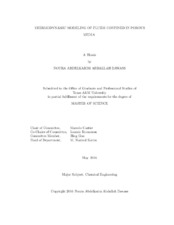| dc.description.abstract | Fluids confined in porous media play a significant role in many engineering applications. Modeling fluids in oil reservoirs, adsorption based separations, and heterogeneous catalysis requires the accurate prediction of thermodynamic properties at a wide range of conditions. For confined fluids, this task involves accounting for the fluid-solid interactions induced by proximity to a solid wall. Most engineering models are only able to predict average properties of the system and fail to give information related to the heterogeneity of the confined fluid. Such information could be obtained through more rigorous but computationally expensive methods. In this work, an approach of intermediate complexity is developed to determine equilibrium properties of confined fluids, and to obtain local distribution of properties in the system. In this model, the variation of properties throughout the system takes place across regions that are defined depending on the effects present. Regions where confinement effects are important are further discretized into layers to capture local distribution within the confinement. For all elements, the volume is specified together with the temperature, and the total amount of each component. Thus, minimizing the Helmholtz energy determines the number of moles in each element; subsequently other properties are obtained. The Helmholtz energy accounts for internal interactions through an equation of state (EoS), in this work the Peng Robinson EoS is used. Additionally, the Helmholtz energy function includes an external contribution represented by an adsorption potential to account for fluid-solid interactions The Steele 10-4-3 potential was used for the confinement of light hydrocarbons in activated carbon. The prediction of local behavior was found to be comparable to the classical Density Functional Theory (DFT) calculations. Moreover, the Dubinin-Radushkevich-Astakhov (DRA) potential was utilized to predict confinement of binary and ternary mixtures of methane, nitrogen, carbon dioxide on activated carbon, and the results were found to agree reasonably well with experimental data. Finally, the ability of the framework to model systems where confinement as well as other effects are present is demonstrated through predicting the molar distribution in a porous reservoir where gravitational effects are accounted for. | en |


